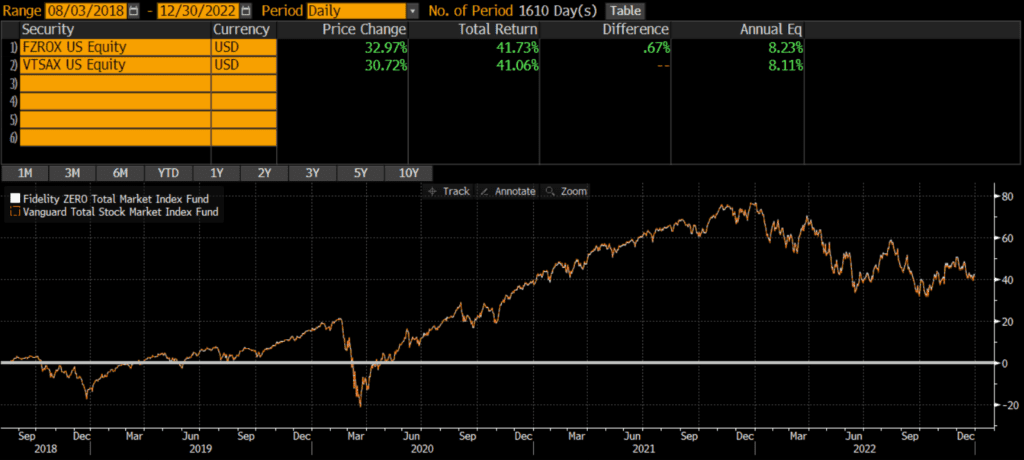The Fidelity ZERO Total Market Index Fund (FZROX) and the Vanguard Total Stock Market Index Fund (VTSAX) are two of the largest “total market” index funds in existence and easily two of the most popular among individual investors. VTSAX and FZROX are the core of many investor portfolios and many investors compare FZROX vs VTSAX in order to decide which should be the foundation of their portfolio.
A quick reminder that this site does NOT provide investment recommendations. Fund comparisons (such as this one) are not conducted to identify the “best” fund (since that will vary from investor to investor based on investor-specific factors). Rather, these fund comparison posts are designed to identify and distinguish between the fund details that matter versus the ones that don’t.
The Short Answer
FZROX and VTSAX are extremely similar, except for one major differences. The major difference is that FZROX can only be bought and/or owned at Fidelity (which is a non-starter for many investors, including myself even if my accounts were at Fidelity).
The underlying benchmark indices that these funds track are technically different (CRSP US Total Market Index vs Fidelity US Total Investable Market Index), but they are identical is most respects. Consequently, the risk and return of FZROX and VTSAX is nearly identical and I consider these two funds equivalent and interchangeable.
The Longer Answer
Historical Performance: FZROX vs VTSAX
VTSAX was launched in back in 2000, while FZROX was launched on August 2, 2018. Since that time, the two funds have had near identical performance: 8.23% vs 8.11% on an annualized basis. Over those years, the cumulative performance differential has been less than .7%!

Differences Between FZROX and VTSAX
Geography
Both the VTSAX and FZROX only include stocks of US-domiciled companies.
Market Capitalization
The two funds have quite a different number of holdings (as of 11/30/2022); VTSAX holds 4,026 stocks versus FZROX’s 2,822 stocks. However, the market cap weighting of the funds are identical.
| VTSAX | FZROX | |
| Large Cap | 73% | 73% |
| Mid Cap | 19% | 19% |
| Small Cap | 9% | 9% |
Sector Weights
The sector weights of each fund are identical, with many sector weights within .10% of each other!
| VTSAX | FZROX | |
| Basic Materials | 2.65% | 2.67% |
| Consumer Cyclical | 10.35% | 10.47% |
| Financial Services | 13.90% | 14.01% |
| Real Estate | 3.48% | 3.46% |
| Communication Services | 6.89% | 6.90% |
| Energy | 5.09% | 5.14% |
| Industrials | 9.80% | 9.59% |
| Technology | 23.04% | 23.15% |
| Consumer Defensive | 6.80% | 6.79% |
| Healthcare | 15.09% | 14.95% |
| Utilities | 2.91% | 2.87% |
Factors to Consider
Expenses
FZROX grabbed headlines when Fidelity announced it, due to the 0% expense ratio. While zero expenses is great, it is only .03% less than VTSAX. So even though the difference in expenses is infinite in relative terms, its only three basis points. At a certain level (such as this one), differences in expense ratios do not matter. Since these portfolios are essentially identical, I would most likely lean towards VTSAX.
Tradability
In my view, the most important factor to consider when evaluating VTSAX vs FZROX is the fact that FZROX cannot be bought or owned outside of Fidelity. Personally, this is a non-starter for me as there are reasons to transfer assets to other custodians, such as transferring one’s accounts or making a donation. Some investors may not value flexibility as much, but they should be aware of this limitation.
Transaction Costs
ETFs are free to trade at many brokers and custodians, although many still charge commissions and/or transaction fees to buy/sell mutual funds. As mentioned, FZROX can only be bought and/or held at Fidelity. So if an investor account is at Fidelity, it is free to trade FZROX but trading VTSAX will cost money.
To my knowledge, Vanguard does not participate in the pay-to-play arrangements that would allow their mutual funds to trade for free on many platforms. So only accounts at Vanguard can trade VTSAX (but they cannot trade FZROX at all!).
Investors looking for an ETF may want to consider VTI, the ETF share class of VTSAX (read our review of VTI vs FZROX here). There is a bid-ask spread when trading ETFs, but this spread is typically less than .01% for VTSAX and individual investor trades will not generally be large enough to “move” the market. In the case of VTSAX, individual investors should not have a problem trading.
Tax Efficiency & Capital Gain Distributions
FZROX routinely makes capital gains distributions, while VTSAX does not make capital gains distributions (nor do I expect it to, due to Vanguard’s fund structure). FZROX is relatively tax-efficient since it is an index fund, but VTSAX is even more tax-efficient.
Final Thoughts on FZROX & VTSAX
FZROX and VTSAX are nearly identical in most respects. Personally, I would not spend too much time trying to divine which fund is “better.”
That being said, investors should not consider FZROX unless their account is at Fidelity. If my accounts were at Fidelity, I might consider FZROX in a tax-exempt or tax-deferred account. However, I would never buy FZROX in a taxable account due to the inability to transfer the assets (without realizing a potential gain) out of Fidelity if I wanted to move my accounts, donate the shares, etc. Therefore, I believe VTSAX is the better choice for most situations, although investor may want to look at similar ETFs too.